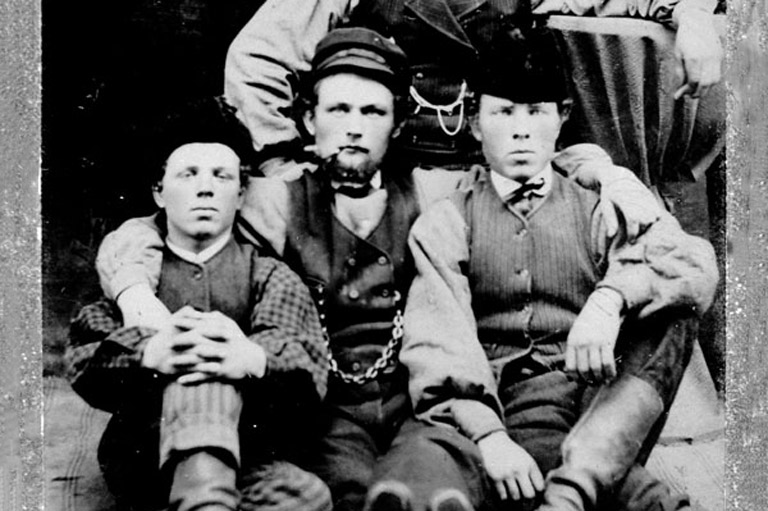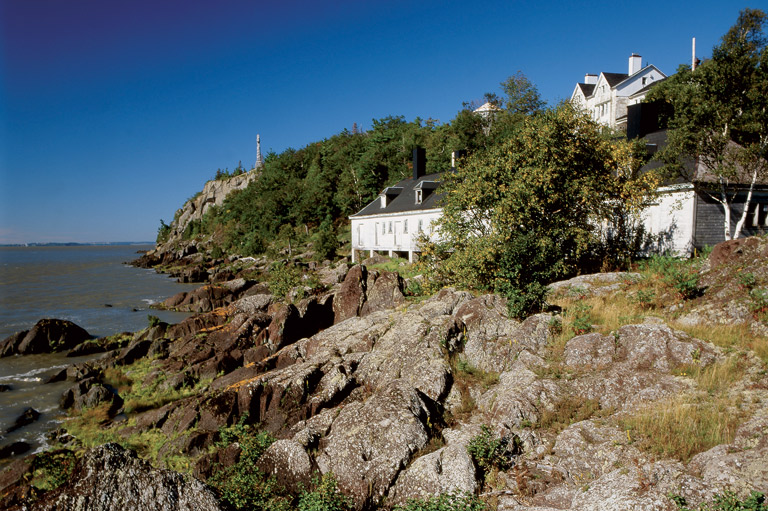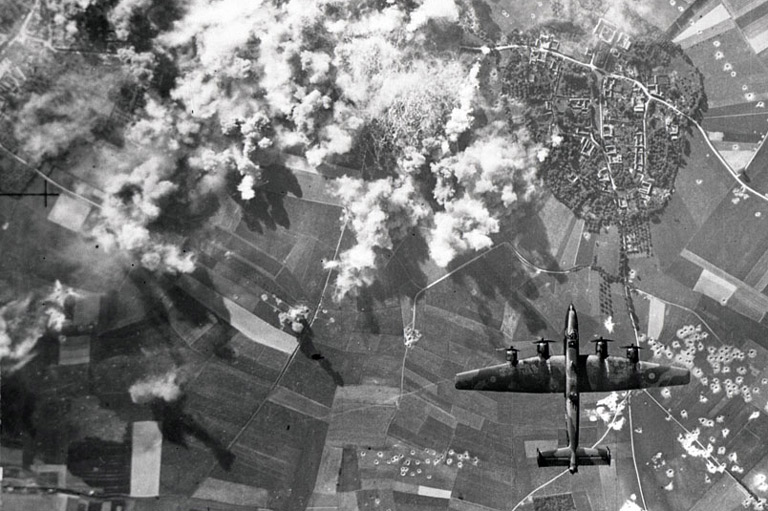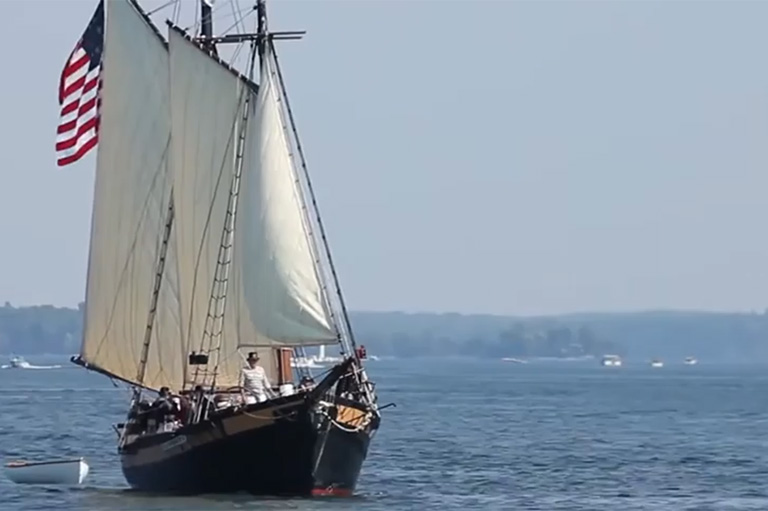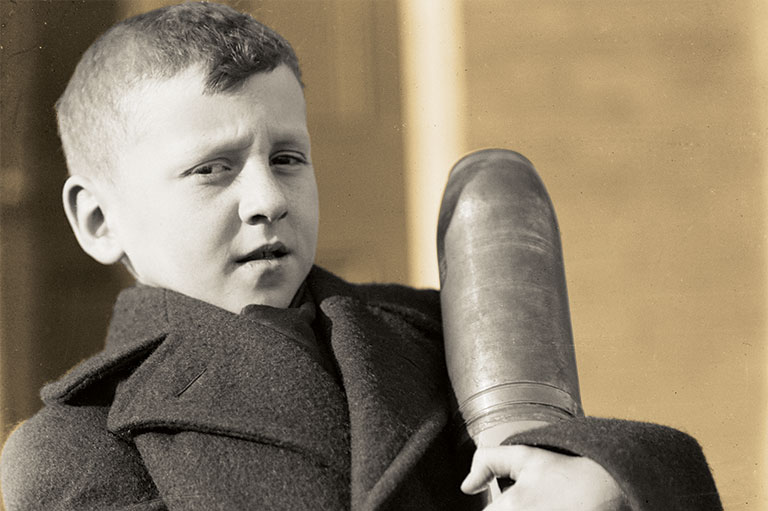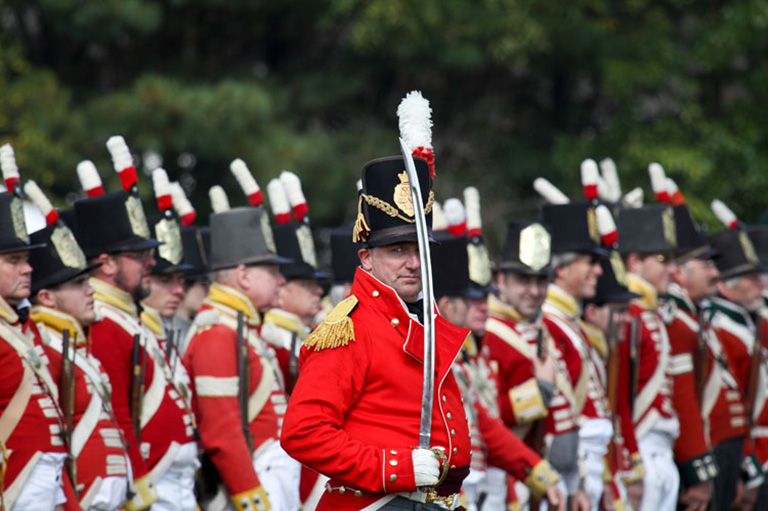War at the Border
John Bell squinted down the barrel of his Ballard Sporting Rifle just as he had many times while target shooting with the other Home Guards. He swallowed the last few morsels of the Boston crackers he'd been chewing, probably the only food he'd eaten on the morning of May 25, 1870. It was now nearly noon.
The twenty or so men around him, local farmers and tradesmen like himself, lay hidden behind the boulders and tree trunks of Eccles Hill, Quebec, keeping a careful watch on the little wooden bridge that spanned Groat's Creek, near the border between the United States and the new Dominion of Canada. Suddenly the men stirred — motioning to each other and whispering sharp warnings.
Bell spotted the figures in blue and green, marching toward the creek like seasoned soldiers. They cheered as they broke ranks to file over the bridge and reassemble on the dirt road on the other side. Bell drew a bead on one figure in a green jacket and blue military cap. At more than 400 metres, the man must have appeared to be no bigger than an insect.
Instinctively, Bell inhaled, probably oblivious to the rich scents of the wildflowers in bloom on that spring morning. He let out half a breath, squeezed the trigger, and felt the butt stock slam into his shoulder as his rifle belched out flame, smoke, and a deadly slug less than twelve millimetres in diameter. He quickly reloaded as the men around him fired at the fleeing figures near the bridge.
When the smoke cleared momentarily, Bell saw that the man at whom he'd fired, John Rowe, a mechanic and volunteer fireman from Burlington, Vermont, lay face down in the dusty road, his hands clenched around his Springfield Rifle Musket. John Bell had killed his first human being.
The remarkable sequence of events that led to the Battle of Eccles Hill began just before the American Civil War. During the 1850s, a clandestine independence movement was born in Ireland. The secret society was called the Irish Republican Brotherhood, or, as they eventually came to be known, the Fenians.
The Fenian dream was to free Ireland from the clutches of the British Empire by any means, and those means included assassination, terrorism, and war in its former North American colony of Canada.
The Fenians' war plan involved a multi-pronged attack to seize Montreal, Hamilton, and Toronto. The invasion date was secretly set for June 1, 1866. However, when the appointed date arrived, it was clear that many of the Fenian forces were not ready to act.
In Buffalo, the commander never showed up, nor did most of the troops called for in the plan. John O'Neill, an intrepid former Union cavalry captain from Kentucky, nonetheless assumed command of two thousand men and seized Fort Erie, Ontario. O'Neill's ragtag army defeated a force of Canadian militia in a sharp engagement at Ridgeway.
However, with his troops cut off from reinforcements, he led a hasty retreat as a larger force of British regulars approached from the north. He was promptly arrested in the United States, but hailed by the Irish-American community as a hero and a patriot.
As events unfolded in southern Ontario, another Fenian force assembled in St. Albans, Vermont, across from Quebec. On June 7, 1866, the West Point-educated Gen. Samuel P. Spear led an unruly force of fifteen hundred Fenians across the border and set up camp in Pigeon Hill, Quebec, about seventy kilometres southeast of Montreal. A skittish band of Canadian militia retreated at the first sight of Spear’s army, and many of the local population took refuge with friends and relatives to the north.
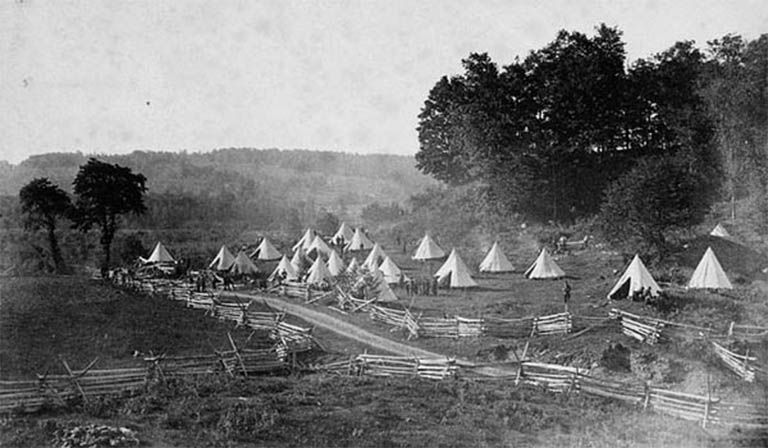
The invasion contravened American neutrality laws, which were first enacted in 1794 and intended to restrict private citizens from involvement in foreign conflicts. In an effort to suffocate the invasion, Maj.-Gen. George Meade of the United States Army, and the victor of Gettysburg, seized supplies headed for the Fenians. Spear’s undisciplined force, cut off from logistical support, responded by plundering undefended homes and farms.
In an incident that would prove to be momentous, a band of Fenians stopped at the Westover farm in Dunham, Quebec, and demanded a hot meal. Asa Westover and his family complied with the request and fed the hungry invaders. However, after eating their fill, the Fenians ransacked the house, helping themselves to the family's valuables. An enraged Westover would never forget this humiliation.
Spear, meanwhile, quickly realized it was only a matter of time before the British army arrived to deal with his Fenian force, which was now dwindling from desertions. Reluctantly, Spear ordered his men to retreat to Vermont on June 9, 1866.
In the ensuing days, the residents of the Canadian border towns, escorted by British troops and Canadian militia, returned to their desecrated homes to repair the damage and rebuild their lives.
The Fenian movement in the United States gained energy from the events of 1866. Participants in the raids, if apprehended at all, were released after short prison terms and treated like heroes in their own communities.
The momentum was short-lived, however. By the late 1860s, infighting and scandals had sapped the movement's strength, causing traditional funding channels to dry up. Realizing that military action increased membership, donations, and enthusiasm, O'Neill — who had emerged as the leader of the most popular faction and was promoted to general — began plans for another invasion of Canada in an effort to shore up declining support.
The men of the Canadian border towns, meanwhile, initiated some planning of their own. Reasoning that the British army and the Canadian militia could not be relied upon to defend them, they resolved to take matters into their own hands.
On June 20, 1868, thirty men signed an agreement at the Seeley Hotel in Dunham, Quebec, which established the Home Guards. The agreement united the men for the “mutual protection of our homes and property ... from any threatened Fenian invasion or other band of robbers.”
Asa Westover, whose farm had been ransacked by the Fenians two years previously, was elected president of the Home Guards. At the time of the agreement, Westover was a fifty-one-year-old farmer whose United Empire Loyalist grandfather had fled Sheffield, Massachusetts, in the midst of the American Revolution.
The Westover farm was prosperous enough to employ three labourers and a servant. Westover was a churchwarden who was active in the choir and contributed generously to the upkeep of the Anglican church in Frelighsburg, Quebec, about seventy-five kilometres southeast of Montreal. There is no indication that he had any military experience whatsoever.
After the defence organization was established, Westover and another member of the Home Guards travelled to the United States to purchase arms and ammunition for the new force. They chose as their main weapon the Ballard Sporting Rifle, a single-shot, small-calibre weapon prized for its accuracy at long range. Usually more suited to the needs of hunters than soldiers, the rifle would prove in the end to be a good choice.
The Home Guards, who met regularly for target practice, were ridiculed by some of their neighbours, who felt a Fenian invasion was unlikely to happen again. Reasoning that Eccles Hill would provide an excellent strategic position in the event of another attack, Westover and Andrew Teneyck, one of the vice-presidents of the Home Guards, visited the south side of the hill on July 1, 1868, to mark fighting positions.
Miss Julia Westover, sister of Asa, would later write after the battle: “I was at home the day Asa and Andrew went with their guns to pick out the spot and range the proper distance to shoot a Fenian.”
In April 1870, the Home Guards, whose numbers had more than doubled, adopted a more military structure and elected Asa Westover as their captain. They also named subordinate officers and chose a sort of uniform — a red sash worn over the right shoulder.
The Home Guards, who had shown remarkable military sophistication in their planning, now revealed their trump card — expert military intelligence.
A Vermont resident, S.N. Hunter, had offered helpful information to the Canadian militia during the Fenian raid of 1866. Since then, Hunter had moved to Canada and joined the Home Guards. However, he remained on friendly terms with his former neighbours in Vermont, who kept him informed about Fenian preparations for war.
On the afternoon of May 23, 1870, Hunter received word that the anticipated Fenian advance was imminent. Hunter raced to Frelighsburg, where he alerted several of the town leaders. Later that evening, he and another member of the Home Guards made a reconnaissance mission over the border. When they reached the town of Franklin, Vermont, near midnight, the townsfolk were gathered in great anticipation as the first wagonloads of Fenian arms and ammunition arrived.
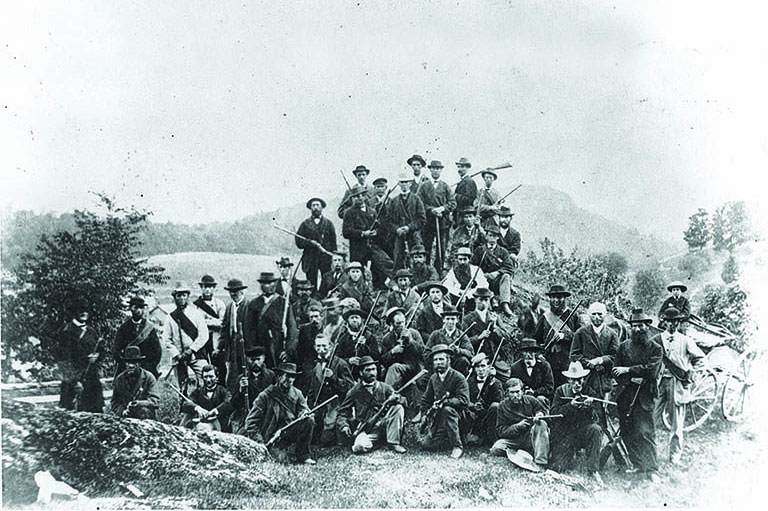
The two Canadian amateur spies raced back to Frelighsburg, where they awakened the town officials and reported what they had seen in Franklin. The local leaders then fired off three telegrams: one to Lt.-Col. William Osborne Smith, assistant adjutant general of the Montreal Military District; one to Lt.-Col. Brown Chamberlin, commander of the local militia force; and one to the provincial government.
After some discussion, it was decided that the Home Guards would assemble on Eccles Hill and take up their carefully marked fighting positions. Dawn was just a few hours away as the call went out to the farmers and tradesmen who were soon to become warriors.
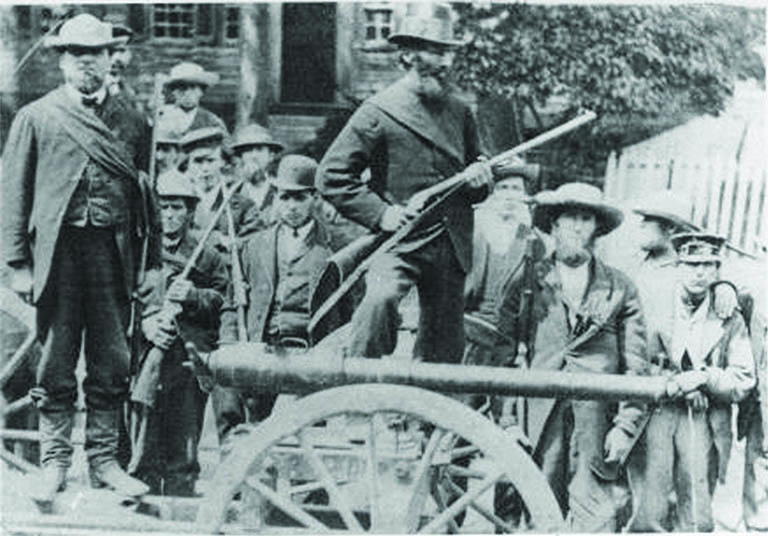
The rain continued to fall during the gloomy morning hours of Tuesday, May 24, 1870, as the Home Guards gathered on Eccles Hill. The anxious men speculated about the activities on the other side of the border. Hunter volunteered to once again scout out the situation in Vermont. This time he found more than seventy wagonloads of weapons, ammunition, and other military equipment stockpiled by the sides of the roads, but he did not see any large concentrations of Fenian troops.
Westover accompanied Hunter to Frelighsburg to report this new information to the authorities. But when the two men arrived, they were informed that Brown Chamberlin and Osborne Smith had cabled back a discouraging response to the telegram that had been sent to them from Frelighsburg the previous day.
The authorities — who were being careful to keep secret their own plans for meeting the Fenian threat — replied that they did not believe Hunter’s reports of Fenian movements to be credible. To the Home Guards, the meaning seemed clear— they could expect no help in opposing the Fenian advance.
As the bleak afternoon drew to a close, Westover assembled the Home Guards and organized them into a night watch and a day shift as they settled in to their grim, determined vigil near the border.
About nine o'clock that night, a messenger arrived from Frelighsburg with another telegram from Montreal. This time the message was more encouraging:
“Westover and Red Scarf Men should occupy old Fenian position at once, if possible, and pester the Hank of any party crossing. I go to Stanbridge [Quebec] by next train. B. Chamberlin, Lt-Col.” The earlier telegram had apparently been part of a ruse to keep the military’s plans secret.
The Home Guards were filled with renewed hope. The Canadian militia intended to join the Home Guards in the fight. The farmers returned to their watch with a strengthened sense of purpose. They would need it.
Shortly alter midnight, the jingle and squeak of an approaching wagon could be heard through the misty darkness. Two Home Guards halted the wagon and asked the driver and passenger their business. One of the men in the wagon whispered the Fenian password, “Winooski,” and then explained that they were to report to O'Neill, the Fenian general. The Fenians were instead briskly spirited away as prisoners of war by an escort of five armed Home Guards.
At four o'clock on the morning of Wednesday, May 25, 1870, twenty-two Canadian militiamen from Dunham arrived at Eccles Hill to reinforce the Home Guards. Near dawn, another twenty militia soldiers came in from Stanbridge, about twenty-five kilometres northwest of Frelighsburg. Although there were rumoured to be thousands of Fenians arriving in Vermont, the sturdy Canadian force at Eccles Hill was growing in strength and confidence.
As the spring sunshine dried the soggy fields around Eccles Hill, Westover released half of his men to get a hot meal. Many of them hadn't left their defensive positions in twenty-four hours. Westover probably feared that, for some, it would be their last meal.
Just after half the Canadian force had left for their breakfast at a local farm, the Fenians began to assemble on the Vermont side of Groat’s Creek. Clad in dark green uniform jackets or blue Union Army coats, the Fenians presented a daunting sight as they formed ranks and shouldered their gleaming Springfield rifles with fixed bayonets.
While many were combat veterans of the Civil War, there were also pink-faced teenagers in the ranks. In his report after the battle, O'Neill said of his soldiers, “Many of them were boys who had never been in a fight before.”
A correspondent with the Boston Daily Advertiser spoke with O'Neill just before the assault and reported, “General O'Neill is in the best of spirits and anticipates no serious resistance in Canada. He hopes there will be enough to amuse his men.”
O'Neill, never one to shy away from drama or bombast, addressed the two hundred or so just before they went to fight, referring to them as “soldiers of the advance guard of the American Irish army, for the liberation of Ireland from the yoke of our oppressor....” With a cheer, the Irish-Americans charged across the bridge onto Canadian soil.
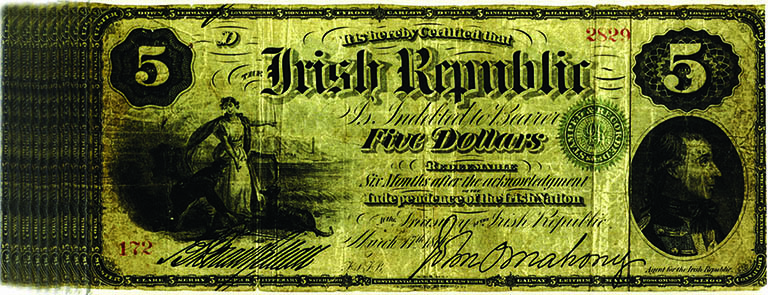
The anxious Canadians gripped their rifles and peered through their sights as they tracked the forward movement of the Fenians invaders. As they had discussed many times, they squeezed off their first rounds only when the green and blue figures reached Canadian soil. At that moment, the Home Guards ceased to be farmers and neighbours — the amusement had begun.
Home Guard John Bell's first shot struck Fenian John Rowe in the neck. Rowe was killed instantly as he pitched forward on the dusty road.
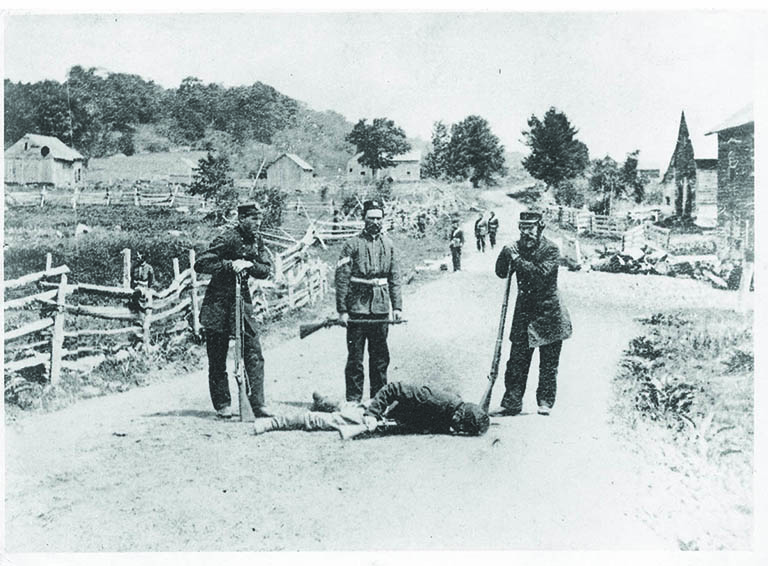
After the initial volley, the Fenians scrambled for cover under the bridge, in the creek bed, and in farm buildings behind the creek. Home Guard Thomas Shephard of Frelighsburg shot and killed Fenian M. O'Brien, of Moriah, New York, as the Irish-American ran for cover through a field behind the creek.
Meanwhile, Osborne Smith, commander of the Montreal militia, had left Eccles Hill and was on his way to Stanbridge Station to bring up reinforcements. When he learned that the Fenian assault had commenced, he reversed direction and galloped full tilt back to Eccles Hill. Disregarding the Fenian fire, the Crimean War veteran rode onto the summit, dismounted, and took command of the border defence.
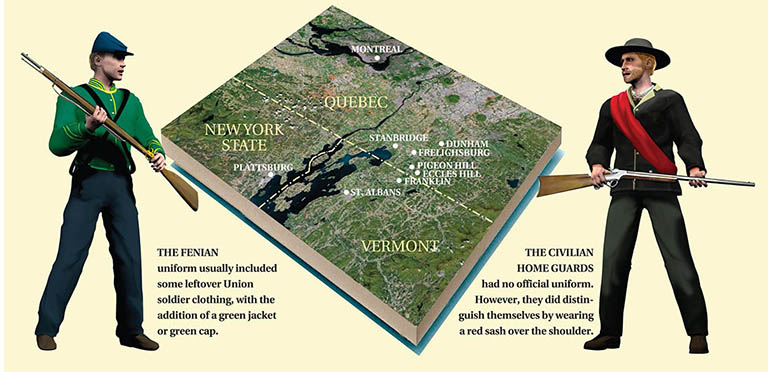
The battle now became a steady firefight, as the well-concealed Canadians exchanged shots with the Fenians, who had found cover near the border. The Franklin House Hotel was converted into a makeshift field hospital as wounded Fenians were evacuated from the border.
A reporter for the Vermont newspaper Burlington Free Press described one victim of the fighting: “He was a boy of nineteen or twenty, in a green jacket and grey trowsers [sic|. He gave us his name — Frank Carrigan of Bridgeport, Connecticut. He was ghastly pale, and suffering much from a wound in the abdomen, the ball having passed down through the groin and thigh. A doctor came as we stood by him, and gave it as his opinion that the ball had gone through the bladder, in which case the wound will be mortal.”
O'Neill, meanwhile, took cover in a Vermont house near the border, directing the attack on Eccles Hill. However, the home’s owner spoiled the Fenian general's vantage point by evicting him.
Until then, George P. Foster, the United States marshall for Vermont, had been helplessly observing the Fenians' flagrant violation of U.S. neutrality laws. Upon seeing O'Neill, he decided it was time for action. Foster arrested O'Neill, spiriting the compliant Fenian commander away to jail in nearby St. Albans.
Critics would later speculate that the apprehension had been pre-arranged between Foster and O'Neill, but the Fenian general would insist that he was abducted by physical force at the point of a loaded revolver.
O'Neill's ignominious exit was observed by a member of his staff, Col. Henri LeCaron, adjutant general, also known as Thomas Billis Beach. The twenty-nine-year-old LeCaron looked on, but did nothing. Years later, the Civil War veteran and doctor revealed himself as a British agent who was reporting directly to Canadian officials.
Meanwhile, John Boyle O'Reilly, a former Irish revolutionary who was reporting for the Boston Pilot, an Irish-Catholic newspaper, temporarily assumed a leadership role and attempted unsuccessfully to organize a Fenian counterattack. (After witnessing the futile Fenian assault on this day, he renounced military action as a method of gaining Ireland's independence, instead favouring political advocacy. He went on to become a renowned journalist, novelist, and Catholic poet.)
As for the Canadian defenders on Eccles Hill, their sharpshooting rifles were trained on two main forces. One was a group of about fifty Irish-Americans, led by Gen. J.J. Donnelly, who were huddled in a valley, where they could neither advance nor retreat without exposing themselves to Canadian fire.
The other was a force of late-arriving New York Fenians, who advanced on a wooded hillside on the Canadian right (they had been misdirected there by the spy LeCaron). The plan was for the New Yorkers to distract the Canadian forces, thus allowing Donnelly's men to escape from the valley. The New Yorkers brought up a six-pound, breech-loading field cannon, got off a few poorly aimed cannon rounds, and then let loose a volley of rifle fire.
Donnelly and his men knew that it was retreat now or risk being taken prisoner. They broke from their covered positions to scramble to higher ground. The Canadians, however, were not distracted by the New York firepower and trained their rifles on the fleeing Fenians. Donnelly was struck in the chest and sustained a serious wound from which he would later recover. The accurate Canadian lire also hit several other fleeing Irish-Americans, but none sustained life-threatening injuries.
Osborne Smith, realizing the Fenian artillery piece posed an immediate threat to the Canadian force, ordered the Home Guards and the Sixtieth Missisquoi Battalion of Canadian Infantry to advance and dislodge the New York Fenians from their position on the wooded hillside.
The Canadians charged down the hill, startling the Fenians, who promptly fled â_” leaving the cannon behind. With great difficulty, officers restrained the jubilant Red Sash men and militia soldiers from pursuing their enemies across the border.
The Home Guards retrieved the cannon, which they regarded as a great war trophy. To this day it rests on the summit of Eccles Hill as a memorial to the Canadian defenders.
As darkness fell, the drama drew to a close. The dejected Fenians retreated to Vermont. The Canadians retrieved John Rowe’s body from the road and buried it by moonlight under a rock cairn on top of Eccles Hill.
Spear, the Fenian general who had plundered the border region in 1866, arrived in St. Albans, Vermont, to send whoever was left with some fight in him over to Malone, New York — where more Fenian supplies were stockpiled — to mount another attack on Quebec and take one more grasp at glory.
However, two days later, a combined force of Canadian militia and British regulars easily repulsed a half-hearted assault on the border at Holbrook’s Corners, Quebec.
On Saturday, May 28, 1870, Maj.-Gen. George Meade arrived in St. Albans with a small American army force to ensure that there were no further violations of American neutrality laws.
On May 30, Lt.-Gen. James Alexander Lindsay, commander of the British forces in Canada, accompanied by His Royal Highness Prince Arthur, son of Queen Victoria, and then serving in Canada with the Rifles Brigade, reviewed the Canadian forces on Eccles Hill.
Lindsay, as “Lieutenant General Commanding Her Majesty's Forces in Canada,” thanked the assembled troops and stated: “Their good service, energy, and promptitude have achieved the utter defeat and the demoralization of the Fenians.” Several years later, a grateful Empire issued medals to all who had fought in the Battle of Eccles Hill.
Eventually, the newspaper reporters and government officials forgot about the small towns near Eccles Hill. O'Neill, Boyle O'Reilly, LeCaron, Osborne Smith, Brown Chamberlin, and even Prince Arthur went on to achieve notoriety or infamy in other places at other times.
Life returned to normal in the lush green fields and wooded hills of Quebec’s Eastern Townships and the Home Guards returned to their farms and businesses. The peaceful border region remained untroubled throughout the natural lives of the Home Guards.
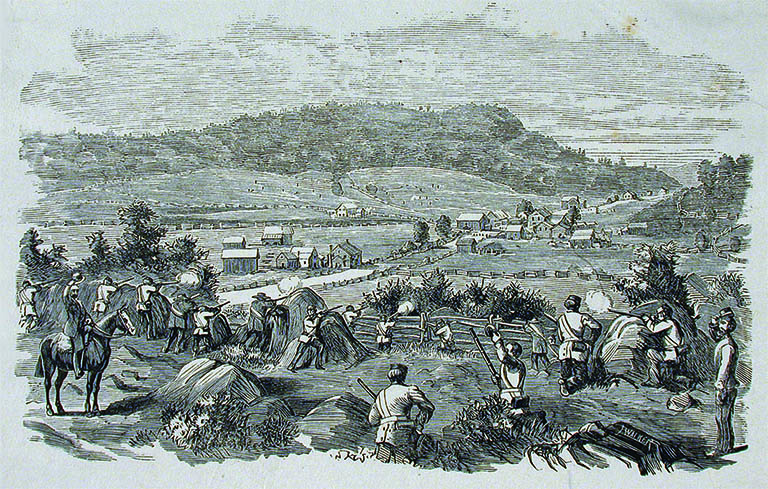
In the end, the Fenian attacks may have had the unintended consequence of strengthening Canadian pride and identity. Historian Hereward Senior, in his 1991 book The Last Invasion of Canada, summed up the effect of the raids:
“For Canada the raids did a great deal. Apart from helping cement federation and improving the quality of the militia, the raids aroused a martial spirit among Canadians that could be enjoyed without the cost of war.”
We hope you’ll help us continue to share fascinating stories about Canada’s past by making a donation to Canada’s History Society today.
We highlight our nation’s diverse past by telling stories that illuminate the people, places, and events that unite us as Canadians, and by making those stories accessible to everyone through our free online content.
We are a registered charity that depends on contributions from readers like you to share inspiring and informative stories with students and citizens of all ages — award-winning stories written by Canada’s top historians, authors, journalists, and history enthusiasts.
Any amount helps, or better yet, start a monthly donation today. Your support makes all the difference. Thank you!
Themes associated with this article
Advertisement
You might also like...

Canada’s History Archive, featuring The Beaver, is now available for your browsing and searching pleasure!

